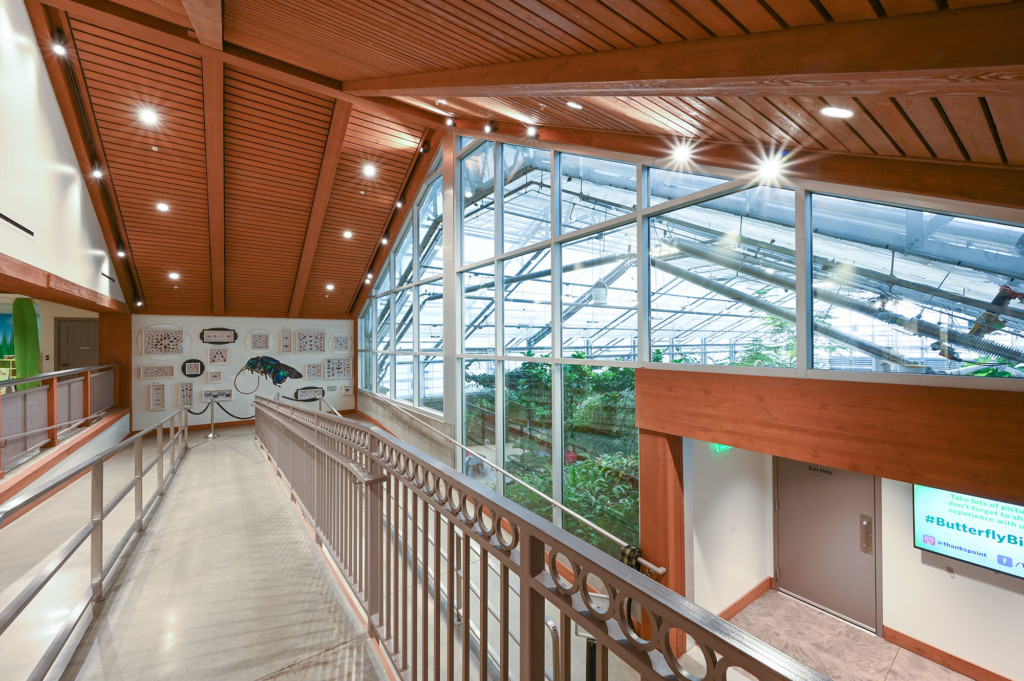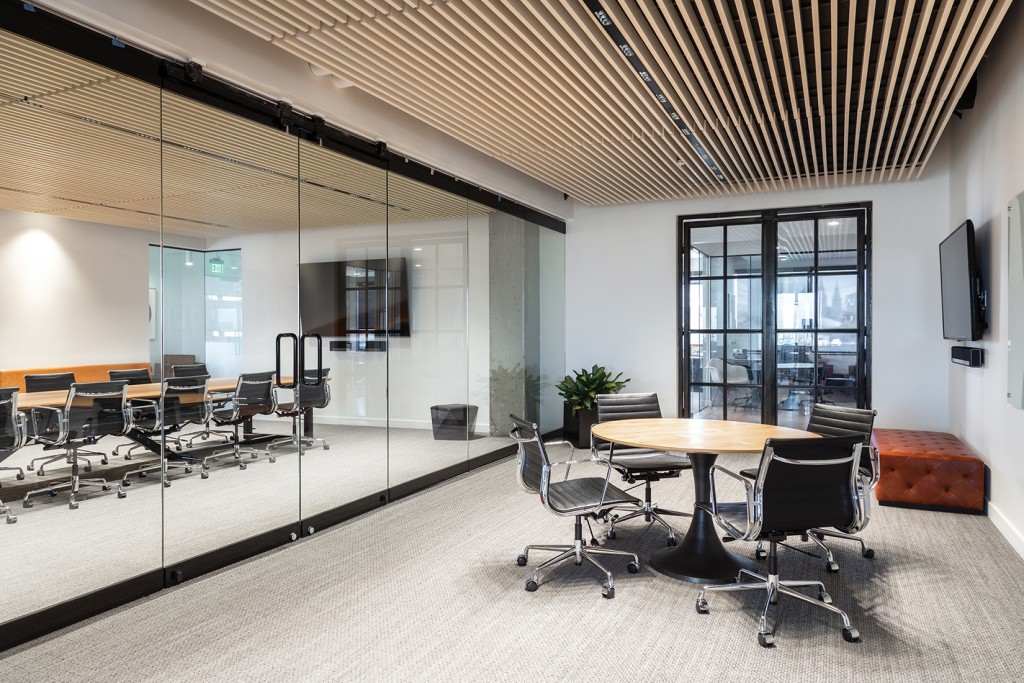Associates at FFKR Architects are committed to supporting each other in their continued professional growth and learning. Each month an associate creates a presentation on a topic of their choice —about design, detailing, or a project.
The following is Ben Edwards’ presentation about Designing for Ability.
Associate Architect Ben Edwards is the only candidate to successfully complete the AIA’s “Seven in Seven” challenge. In 2016 he sat for all 7 sections of the ARE (Architect Registration Examination) in seven consecutive days –and passed each one. Ben is also deaf. He, like many Deaf people, does not consider himself disabled. Rather, he sees himself as differently abled. He benefits from Deaf Gain*, rather than suffering hearing loss.

On the left, Architect Ben Edwards
The idea of Deaf Gain includes the benefits and gain of learning American Sign Language and being part of a culture and history that has contributed to broader society in so many ways. Did you know baseball signs from umpires originated when deaf players asked for a signal to indicate a ball, strike, etc? In the days before PA systems, this also helped fans understand what was happening on the field. And deaf football players first formed “huddles” to prevent the opponents from seeing them communicate in signs and to keep their plays a secret – a behavior still practiced on the field today. Solutions were designed for the abilities of the Deaf, but the benefit extended to everyone. Deaf people have similarly contributed in other fields ranging from visual arts, movie making, and storytelling, to the hard sciences in language development, neurology and more.
Ben shared with our Associate Architects, Landscape Architects, and Interior Designers the benefit of approaching design for differences from an ability centric point of view, rather than strictly to enable access as required by ANSI Codes and ADA compliance. Delivering only on the minimum of code compliance, opportunities are overlooked, and we miss the chance to benefit the greater population and achieve what he referred to as Human Gain. To design for Human Gain people are viewed as having differing abilities and one considers the lifestyles and behaviors that result. By understanding how individuals adapt the world to their lives, and incorporating that understanding into our design, all will benefit. The design will likely provide unanticipated benefits that otherwise may not have been considered.

Chris Downey is an architect who went blind. Ben shared with this group, that in an interview with CBS news, Chris discussed the impact that change had on his career. He became acutely aware of sound, and textures and how they change in these enclosed spaces. Chris also says, “I’m convinced I’m a better architect today than when I was sighted.”
Chris was engaged to assist in designing a solution to help the visually impaired navigate San Francisco’s four block long Transbay Transit Center. “How on earth do you navigate this size of facility if you’re blind?” Certainly, braille could have been included as required by ADA on all directional signage.
However, Chris’ solution focused on ability. He incorporated grooves into the concrete, running the entire length of the platform. A subtle change from smooth to textured concrete signals where to turn to get to the escalators. This ability driven design solution creates an enhanced wayfinding strategy for both the sighted and the blind.
In 2005, architect Hansel Bauman, of hbhm architects, established the DeafSpace Project (DSP) in conjunction with the ASL Deaf Studies Department at Gallaudet University. Over the next five years, the DSP developed the DeafSpace Guidelines. This catalog establishes over one hundred and fifty distinct architectural elements to address five aspects of the Deaf experience, and the Deaf experience is influenced by the built environment. Ben spoke about how these five aspects; Sensory Reach, Space Proximity, Mobility Proximity, Light and Color, and Acoustics play in the everyday experience of Deaf people.


Ben shared that the Deaf cannot rely on sound for cues as to what might be happening around them. They do not hear the footsteps of people approaching, or someone calling their name to start a conversation. Therefore, Sensory Reach enables them to take cues from changes in light and shadow, reverberations in the floor or the movement of people to maintain awareness and respond to activity around them. Ben has known deaf people to mount mirrors on their monitors at work, to extend their Sensory Reach, and see if someone is approaching from behind. Additionally, he described that a deaf conversation can’t happen while walking side by side. You must be able to look at the other person to see what they are saying. Therefore, providing enough space in corridors and maintain an awareness of surroundings by easily seeing around corners if others are approaching are important design considerations. (Therefore, important design considerations should provide enough space in corridors, an awareness of surroundings and how easy it is to see others approaching around corners.)
Open spaces, transparency, and good lighting all maximize the abilities of the Deaf, and at the same time create a pleasant environment and experience for others.
Sensory Reach
Consideration: Visual and tactile cues provide ability to sense and perceive what is happening around you.
Design Solution: Translucent / transparent panels and openings for sightlines to see beyond immediate spaces what else is happening.
Mobility and Proximity
Consideration: Space to move and communicate with each other, watch for each other and avoid obstacles.
Design Solution: Wider aisles and curves or visibility at corners, ramps instead of stairs where possible, to minimize need to look away from other people towards where one is going.


Ben discussed how he must be able to easily see the person speaking or signing. He relies on clear sightlines as well as good lighting for conversations. He described a Deaf group engaged in animated conversation. The group will naturally find themselves in a circle, or at least a semi-circle. The focus quickly changes from one speaker to another, organically just as any other discussion might. However, where a hearing person would butt in, say “excuse me,” “I think..” or give some other verbal cue, a deaf person may bang on the table, wave, or give some other indication that they have something to add.
He told a story of a workplace presentation where the lights were dimmed so that projection could be easily seen on the screen. However, the room became so dark it was difficult to see the interpreter signing. Thoughtful lighting design could have created independently controlled zones within the ceiling plan, avoiding the all-or-nothing scenario. Lighting could allow people to see the presenter, the presenter could gauge attendee responses and reactions, and allow attendees to better see and take notes.
Imagine a conversation in a typical conference room, or even restaurant with rectangular tables. You may be able to hear someone’s comments without looking at them. However, you don’t have the benefit of easily seeing faces for various subtleties, and the easy give and take of seeing when the next person has something to add. You may have to lean and crane your neck to see or engage a person at the other end of the table. Designing for the abilities of the Deaf would result in a round, or semicircular arrangement, benefiting the engagement of all participants. For lectures and classrooms, semicircular arrangements are common to allow everyone to see questions asked by students as well as answers given by the teacher. Other alternatives include oval or elliptical tables which provide some adaptions for existing rectangular rooms.
Space and Proximity
Consideration: Space for signing, eye contact for all, spaces may need to be larger and circular for people to see each other.
Design Solution: Meeting spaces should provide circular or semi-circular seating, and spaces provided for small gatherings.
Light and Color
Consideration: Poor lighting conditions interrupt visual communication. Strain contributes to eye fatigue, interruption and physical exhaustion.
Design Solution: Even, diffused lighting and color to contrast skin tone to highlight sign language and facilitate visual wayfinding.
Acoustics may not seem like a big deal for Deaf people, but many have varying levels of hearing abilities and those with hearing aids or cochlear implants can be as distracted as any hearing person by extra noise or conversations. Ben explained, “we are aware of situations negatively affecting legibility in conversations because we often see situations where sign language interpreters have trouble hearing the presentation. Because interpreters do not always know intimately the topics that may be covered, they may miss or get incorrect information as a result of ambiguous sounds in an acoustically hostile or cluttered space.”
Ben pointed out that it is important to remember that not all disabilities are visible. We typically associate accommodations with wheelchairs and access. However, mobility differences are wide ranging, and not all require supportive equipment. Issues extend from general weakness, to limited dexterity to an inability to walk without assistance; with varying degrees of all. If we think about supporting varying ability by integrating places to stop and rest, providing hand holds for balance, and simple, easily managed controls, these are all design elements that when included, benefit all users.


Ben suggests that designing a better experience for all means considering sensory, social / interactive abilities as well. Sensitivity to environmental conditions extends beyond sight and hearing. Individuals may have acute sensitivity to texture, heat/cold, even smell. Providing the ability to control local environmental elements like ventilation, lighting, and temperature supports these individuals, as well as benefiting general occupants. Individuals with autism, severe anxiety or phobias may find interaction with others challenging. Therefore, making information clear and accessible without the need to ask others for assistance is crucial, and makes navigating new places easier for all.
FFKR takes a user-centered, intentional approach to design decisions for elements like these and others. The results are optimized spaces, functions, and experiences for all.